
|
 Downloads
Downloads
|
 Prices
Prices
|
 Videos
Videos
|
GeolOil - Water saturation equations: Archie, Simandoux, Indonesia, Fertl, and SW ratio
 This is one of our most referenced articles on the internet
This is one of our most referenced articles on the internet
The Archie equation was the first empirical model built (1942) to estimate the water saturation in non conductive matrix rocks. It usually works well with clean clastic sandstones and carbonate rocks. Typical parameters for the Archie equation for consolidated sandstones are a=0.81 (tortuosity), m=1.7 (cementation exponent), and n=2.0 (saturation exponent). For carbonates, typical parameters are a=1.0; m=n=2.0.
When the rock matrix has some electrical conductivity, the resistivity is not only a function of the water resistivity Rw through their free dissolved ions, but also depends upon the matrix rock minerals beside the non conductive quartz and calcite matrix grains. The most common cases happen on clastic shaly rocks with important content of clay minerals.
In these shaly rocks the Archie law over-estimates the water saturation. Many models consider the Shale Volume (Vshale or Volume of Shale) in the matrix to account for the excess of conductivity. The Simandoux equation (1963) is among the most used ones. It reduces mathematically to the Archie equation when n=2 and Vsh=0. Below are the expressions for the general Archie and Simandoux equations:
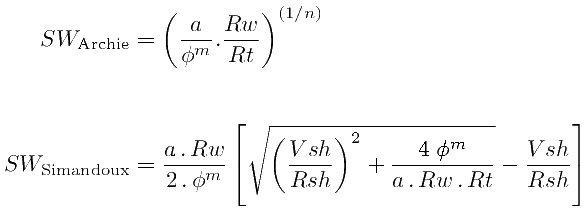
Other popular models that deal with shaly sands are the Fertl (1975) equation, and the 1971 Poupon-Leveaux (Indonesia) equation.
The Indonesia equation may work well with fresh formation water. The parameter Rshale (resistivity of shale) is usually taken from the resistivity reading of a nearby pure shale, assuming that the clay cements & silt, and the shale nature, are similar to those of the shaly sand.

The Fertl (1975) equation for shaly sands has the advantage that does not depend upon Rshale. It uses instead a reservoir dependent empirically adjusted 0.25 ≤ α ≤ 0.35 parameter α:

There are two equations that occasionally yields reasonable estimates for the water saturation —even if there are no estimates for porosity— when the resistivity of the flushed zone Rxo, and the mud filtrate resistivity Rmf are available:

The former equation is called the Archie SW ratio, and requires a clean, non-shaly, non-conductive matrix to work. For the cases or moderately shaly matrixes, we introduced on April 2020 the following approximate correction to deal with the excess of matrix conductivity:
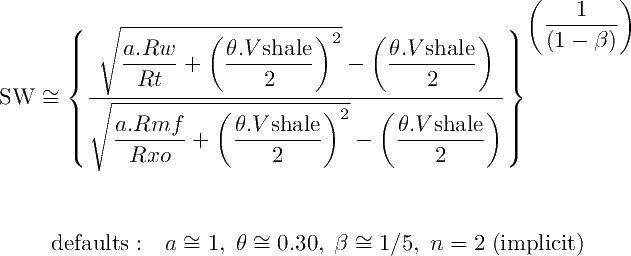
Notice that all the electrical equations shown above to estimate SW require to know the value for the formation water resistivity Rw. This is usually the most important parameter to estimate SW. The table below shows the most popular techniques aimed to estimate either salinity or its companion Rw value at the reservoir temperature:
NaCl or Rw Method |
Qual. |
From |
Remarks |
|
| 1 | Ionic Water Analysis | Best | Water sample | Water sample must be representative. Independent, log free technique |
| 2 | Rw from water bodies and pockets | Good | Logs | Needs to find 100% water bodies to work, like aquifers or water pockets |
| 3 | Hingle Plot | Good | Logs | Same math as Rw from H2O body, but from a cross-plot. |
| 4 | Core SW vs. log SW match | Med. | Logs and Core | Move salinity until match. Needs accurate lab SW measurements. |
| 5 | Pickett Plot | Poor | Logs | Rw & m estimation. Does not work if Phi is almost constant in water body |
| 6 | SP Spont. Potential | Worst | Logs | Last resource to try. Seldom yields accurate or usable Rw estimates |
Techniques to estimate equivalent NaCl water salinity and Rw
GeolOil has +19 built-in models for water saturation: Archie, Fertl, Simandoux, Schulumberger, Poupon-Leveaux (Indonesia), SW ratio, laminar shales, Dual Water, Juhasz, Waxman-Smits, Archie flushed zone ratio, irreducible low bound, irreducible Timur, saturation height through capillary pressure, and others.
All water saturation equations yield similar results to the Archie equation for moderately clean sands (see the aqua color clean sand zone in the picture below). However, the results differ in the case of shaly sand (see the pink color shaly sand zone), where the Archie law clearly over-estimates the water saturation (too much water, so a pay zone could be easily missed if the Archie equation is the only model used).
The two following tables help to figure out how the water saturation SW and the hydrocarbon saturations SO and SG, move by trend increases or decreases on the electrical parameters a, m, n, Salinity, Rw, Rt, Vsh, Rsh, φ, α, and Cation Exchange Capacity Qv. As each parameter changes, the remaining ones are kept constant for sensibility comparisons.
|
How SW, SO and SG change as a parameter increases
|
How SW, SO and SG change as a parameter decreases
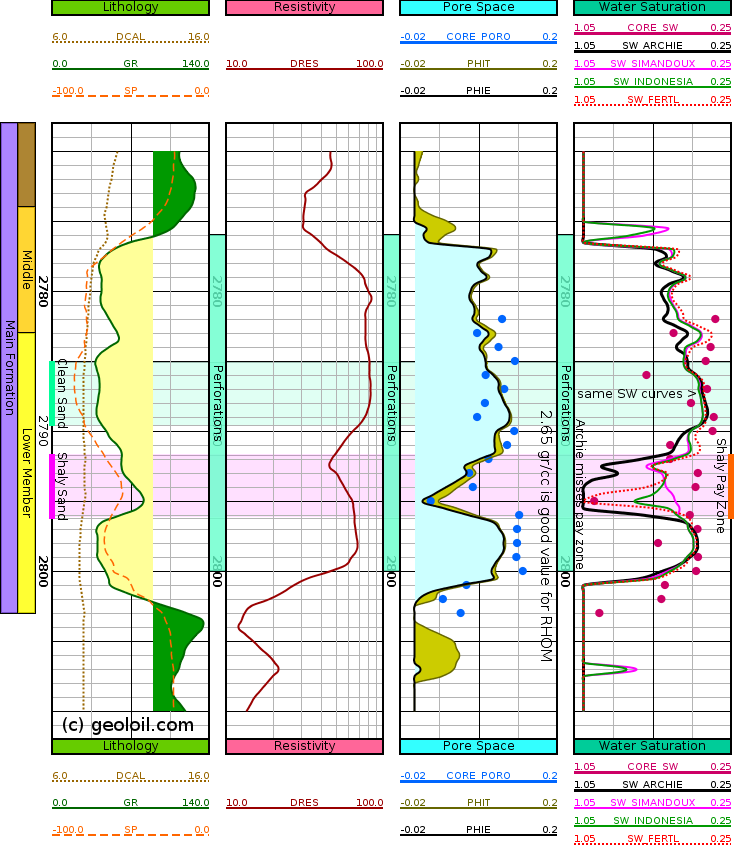
Comparing the results of Archie, Simandoux, Indonesia, and Fertl models
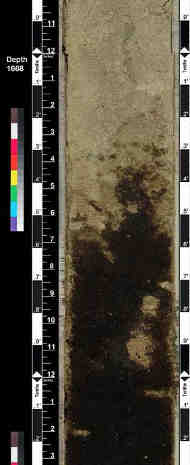
A sealing shale blocking black oil to migrate upwards
The photograph above shows at its top, a classical pure gray shale with VSH = 1.00 (VCL = 0.83, and Vsilt = 0.17). This shale is an effective seal that blocks the upwards migration of oil.
The zone at the bottom, shows an oil impregnated, shaly sand. The oil impregnation is seen as the black stains on regular light. You are welcome to see the photograph in full size.
If the Archie model would be applied to the oily shaly sand, it would forecast too much water. Hence overlooking the searching for oil, and underestimating resources.
A correction to take into account the excess of conductive clays in the shale is needed. All the models shown above that incorporate shale adjustments would yield more realistically, less water saturation and more oil.
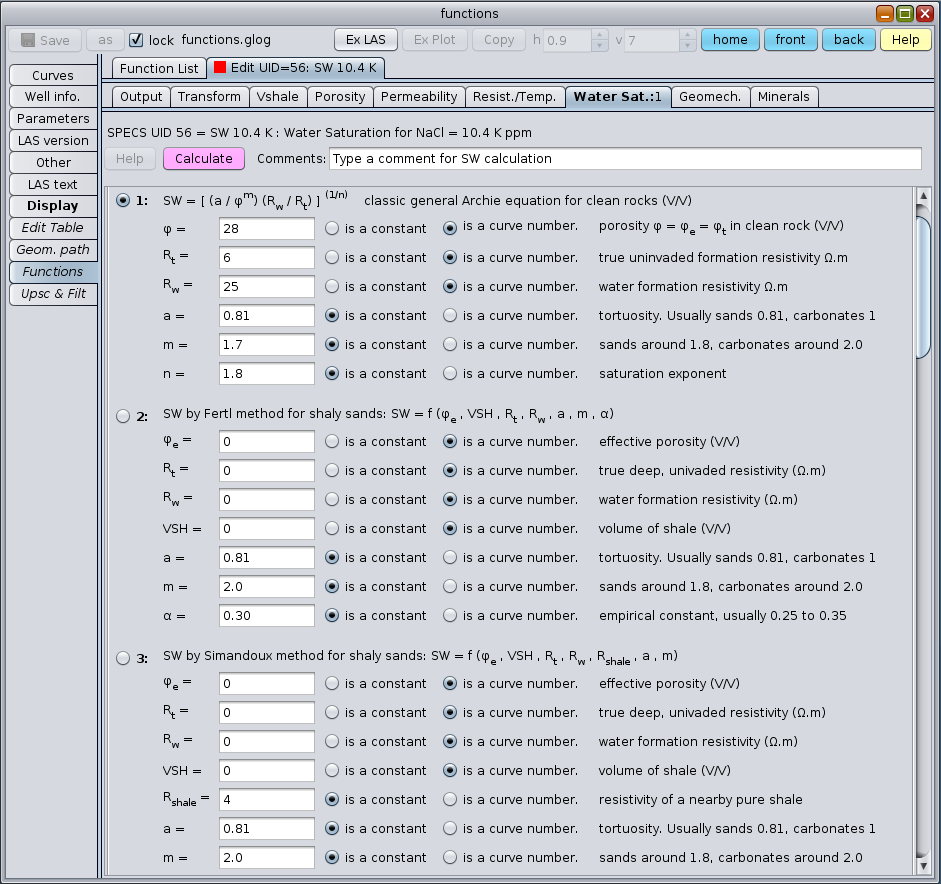
Panel to compute water saturation using Archie, Fertl, & Simandoux equations

Panel to compute water saturation using Poupon-Leveaux (Indonesia) & Dual Water Model algorithms
 GeolOil is listed by the official
SPWLA software directory
GeolOil is listed by the official
SPWLA software directory
| |



|
|
|
© 2012-2026 GeolOil LLC. Please link or refer us under Creative Commons License CC-by-ND |




 TRAINING
TRAINING

 PAPERS
PAPERS
 REFERENCES
REFERENCES
 GET IN TOUCH
GET IN TOUCH


